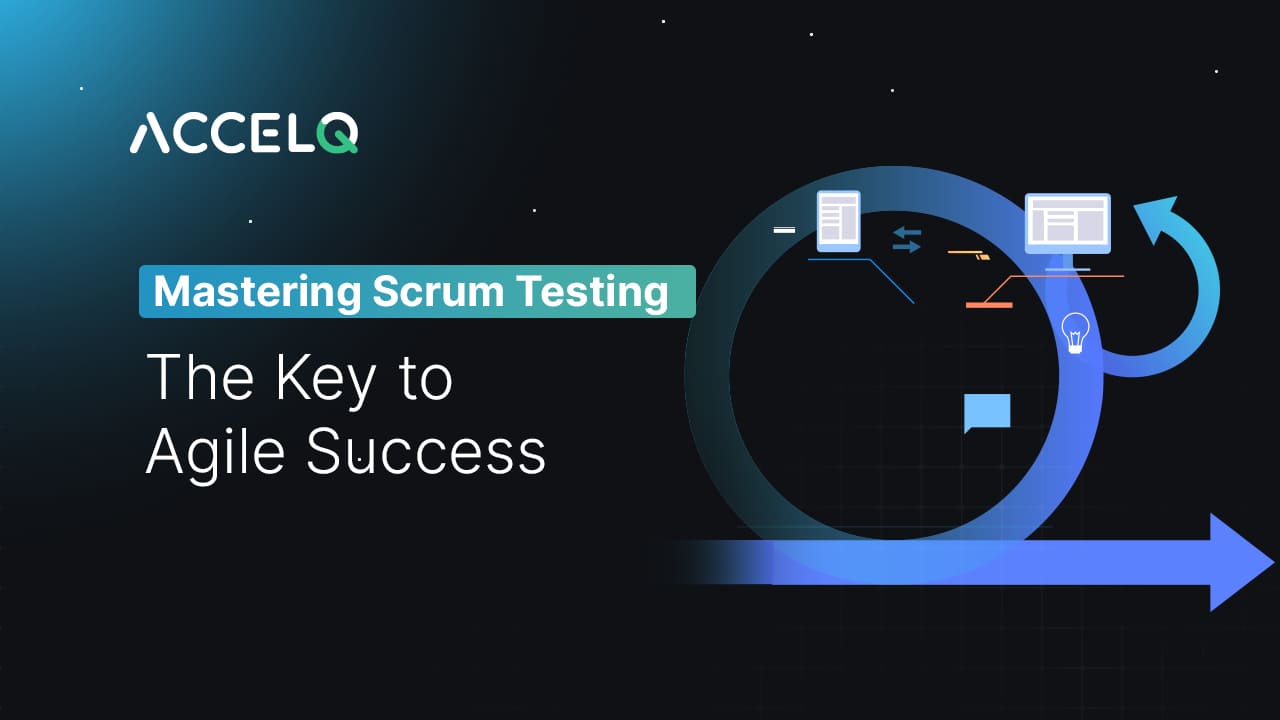Mastering Scrum Testing: The Key to Agile Success

Scrum is a successful methodology that focuses on delivering business value collaboratively and incrementally in the shortest possible time. It emerged as a response to the need for flexible, accelerated, adaptive, and simplified product development. As a result, most agile teams today use Scrum testing to build confidently, meet development timelines, and ensure timely releases.
What Is Scrum Testing?

Scrum is not an acronym but a term that originates from Rugby. A Scrum is the act of the team coming together to move the ball forward. In software development, Scrum refers to the set of activities needed to move the product forward.
Scrum is a subset of the agile environment and addresses complex issues to deliver high-quality products simultaneously. In Scrum, tasks are divided into time boxes (small time frames), and the delivery of specific features happens incrementally. The final build has all the features required by the customer.
Scrum testing is the assessment of the ability of the software or application to execute complicated processes. Scrum testing checks functional and non-functional parameters like security, usability, performance, etc.
What Are the Scrum Testing Goals?
A team tests a build to assess whether it performs as expected. The goals of scrum testing are to:
- Assess the complexity of the software
- Evaluate the quality and performance of the software
- Assess the usability of the software
- Provide support to unit testing
Download the 100% Free Guide
Master the essentials of advanced approach
to object recognition.

Why Is Scrum Testing Important?
Scrum has now become an integral part of the agile methodology. The focus on Scrum keeps increasing as applications increase in complexity and become business-critical. As it stands, Scrum testing enables organizations to build complex applications with more confidence as it allows teams to focus on all aspects of software development with a heavy focus on performance, quality, and usability.
In the Scrum methodology, each feature is completed before moving on to the next iteration. As such, in this methodology, testing becomes integrated into the development processes and is conducted throughout the lifecycle.
Testing early and testing often results in greater confidence in the product and more transparency into elements that are not working and issues that need remediation. As a result, teams can build robust, bug-free applications irrespective of the complexity involved.
Is There a Difference Between Agile and Scrum Testing Methodology?
While Scrum and agile testing might look similar, there are a few differences between the two. Here are some of the main differences:
- Agile testing focuses more on the product owner. On the contrary, Scrum testing is all about the team.
- The design and implementation of agile testing is simple. In Scrum, this is a more complicated process since it focuses on iterative development, and tasks are divided into time boxes.
- In agile testing, the developers and the business teams work together throughout the project. Scrum testing, however, begins with the product vision.
- Agile test planning takes place on three levels. These are release planning, iteration planning, and daily planning. On the other hand, Scrum testing focuses primarily on iteration planning.
- Working software is the measure of progress in agile testing. However, in Scrum, how the software features under development work and how they perform after consolidation become the measure of progress.
- Agile testing has now become a default part of every software development project. On the contrary, organizations usually pursue Scrum testing to test complex features where requirements change rapidly.
Mastering the Scrum Testing Methodology
In Scrum testing, the testing team tests a product to assess its development from the customer's perspective. The following pillars support the Scrum testing methodology:

1. Roles
There are three chief roles in Scrum testing: the Product Owner, Scrum Master, and the Team.
The Product Owner defines the features of the product, decides the release dates and corresponding features, and prioritizes the features according to the market value and profitability of the product.
The Scrum Master manages the team and drives the team's productivity. They coordinate with all roles and functions, maintain block lists, and remove barriers in the development processes. Furthermore, they plan the daily Scrum and drive sprint review and planning meetings.
The team comprises developers, designers, and testers and focuses on development and testing.
2. Release Planning
Release planning is an important part of the Scrum framework. The release plan in Scrum is called the sprint backlog. The sprint backlog is a list of all tasks that must be completed to release the product in the market.
This plan takes into consideration not only the tasks that need completion in the current sprint but also details the tasks that need to be completed in future sprints.
3. Sprint Planning
Sprints are time-boxed periods during which a team has to complete a specific product addition. The work in a sprint is done based on user stories and backlog. Sprint planning plays a very important role in Scrum's success. It is a subset of agile release planning and keeps its focus solely on the sprint phase of a project.
A sprint imports stories from the release backlog into the sprint backlog. Scrum Master hosts it and it involves making the effort and time estimates for testing the various stories in the sprint backlog.
4. Daily Reviews
Daily reviews play a crucial role in driving Scrum's success. This activity assesses the progress status and identifies the tasks that have been completed the previous day and the work that has to be done that day and the next. The team also identifies possible resolutions to challenges or issues encountered during a sprint in the daily Scrum.
5. Sprint Review
The sprint review is an informal meeting attended by the development team, the Scrum Master, the Product Owner, and the stakeholders. Sprint reviews are more detailed than daily reviews. During these reviews, the team gives a demo of the product and determines the features and functionalities that need focus to build towards completion.
6. Setting up a Test Automation Framework
Test automation plays a key role in accelerating testing and development velocity. In Scrum testing methodology, test automation continues to play a pivotal role in increasing the testing footprint and speed.
Given that Scrum identifies complexities and helps build complex applications faster, successful test automation involves identifying the best and the main candidates for automation such as functional, API, UI, UX, and End to End Regression etc..
Test automation has to move hand in hand with the development process. However, Scrum testing needs a stable and reusable test automation tool that can perform different levels of automated tests. The platform should completely support API, UI, UX, end-to-end, and regression testing.
Addressing the Challenges in Agile Scrum Testing
Agile Scrum testing lends itself well to test automation and is not heavily tester dependent. However, some of the common challenges of Scrum testing are:
- Estimating the testing effort for each user story
- Evaluating the environment and resource constraints v/s team’s capacity
- Managing dynamic requirements
- Increased regression risk with frequent code changes
- Need for simultaneous test planning and execution
The key objective of Scrum is to deliver high-quality software iteratively. For this, testing velocity has to be at par with development speed. QA also needs to be able to check testing progress with a continuous feedback loop. However, the complexities at play are hard to ignore.
As such, a robust, AI-powered, no-code test automation platform becomes a critical enabler of testing success. Functions like visual elements and removal of dependencies on programming languages to write test cases alleviates the challenges posed by Scrum testing. These features also ensure that the test automation platform does most of the hard work for Scrum testing.
Connect with us to see how ACCELQ's test automation platform simplifies Scrum testing for your organization and allows you to develop and release complex applications with confidence and speed.
Related Posts
 What is Automated Security Testing? Why & How?
What is Automated Security Testing? Why & How?
What is Automated Security Testing? Why & How?
 Accelerate your Testing with ACCELQ
Accelerate your Testing with ACCELQ
































